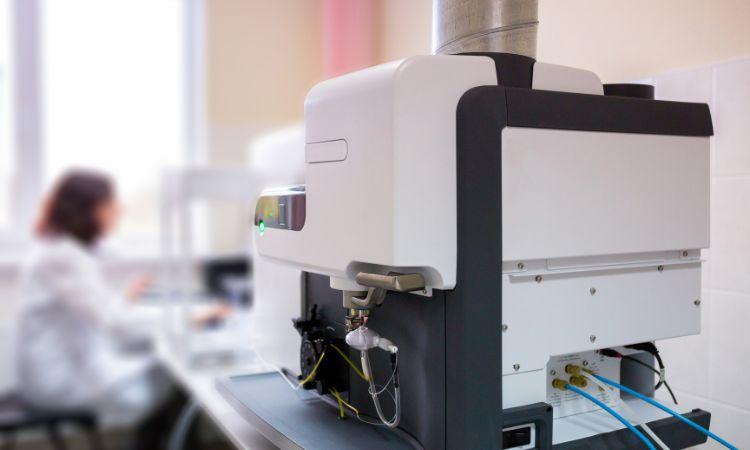The global atomic spectroscopy market size attained a value of nearly USD 5.9 billion in 2021. The market is further expected to grow in the forecast period of 2024-2032 at a CAGR of 6.3% to reach approximately USD 8.5 billion by 2032. This remarkable growth reflects the increasing significance of atomic spectroscopy in scientific research, quality control, and various industries worldwide. In this blog post, we will delve deep into the world of atomic spectroscopy, exploring its techniques, applications, advantages, limitations, recent technological advancements, and future prospects.
Section I: Atomic Spectroscopy Techniques
A. Atomic Absorption Spectroscopy (AAS)
Atomic Absorption Spectroscopy (AAS) is a fundamental analytical technique widely used for the determination of trace elements in various samples. It operates based on the principle of absorption of specific wavelengths of light by ground-state atoms in a sample.
1. Principle and How it Works
In AAS, a light source with a specific wavelength is directed through the sample, which contains the analyte of interest. The atoms in the sample absorb this light, promoting some of their electrons to higher energy levels. By measuring the amount of absorbed light, we can quantify the concentration of the element in the sample.
2. Application Areas
AAS finds applications in diverse fields, including:
- Environmental Analysis: Detecting heavy metals in soil and water.
- Clinical Chemistry: Measuring trace elements in biological samples.
- Food and Beverage: Ensuring food safety by analyzing metal contaminants.
B. Atomic Emission Spectroscopy (AES)
Atomic Emission Spectroscopy (AES), also known as optical emission spectroscopy, is another powerful technique used to identify and quantify elements based on their characteristic emission spectra.
1. Principle and How it Works
AES involves subjecting a sample to high-energy conditions, such as a flame or plasma. This excites the atoms in the sample, causing them to emit light at specific wavelengths. The emitted light is then analyzed to determine the elemental composition of the sample.
2. Application Areas
AES is applied in:
- Metallurgy: Analyzing metal alloys for quality control.
- Geology: Identifying elements in geological samples.
- Astrophysics: Studying the composition of stars and celestial bodies.
C. Atomic Fluorescence Spectroscopy (AFS)
Atomic Fluorescence Spectroscopy (AFS) is a technique that measures the fluorescence emitted by atoms after absorbing light of a specific wavelength.
1. Principle and How it Works
In AFS, a sample is exposed to a light source, similar to AAS. However, instead of measuring absorption, AFS measures the fluorescence emitted by the excited atoms when they return to their ground state. This fluorescence is used to quantify the analyte’s concentration.
2. Application Areas
AFS is employed in:
- Environmental Monitoring: Detecting trace levels of pollutants.
- Biological Research: Analyzing metal ions in biological samples.
- Geological Studies: Studying the composition of rocks and minerals.
D. Comparison of Techniques
To help you choose the right technique for your specific application, here’s a brief comparison of AAS, AES, and AFS:
- AAS: Ideal for quantifying trace elements with high sensitivity.
- AES: Used for qualitative and quantitative analysis of multiple elements.
- AFS: Provides high sensitivity for specific analytes, especially in environmental and biological applications.
Section II: Applications of Atomic Spectroscopy
A. Environmental Analysis
The applications of atomic spectroscopy in environmental analysis are extensive and crucial for monitoring and mitigating environmental pollution.
1. Detection of Heavy Metals
AAS and AES are commonly employed to detect heavy metals such as lead, mercury, and cadmium in soil, water, and air. These elements pose serious health and environmental risks when present in excessive amounts.
2. Monitoring Pollutants in Air and Water
Atomic spectroscopy techniques play a vital role in monitoring air and water quality, ensuring compliance with regulatory standards. They are used to detect pollutants, including volatile organic compounds (VOCs) and hazardous metals, in industrial emissions and natural water sources.
B. Pharmaceutical Industry
In the pharmaceutical industry, atomic spectroscopy is essential for quality control and drug development.
1. Quality Control of Drug Formulations
AAS and AES are employed to verify the composition and purity of pharmaceutical products. Ensuring that drugs contain the correct amount of active ingredients is critical for patient safety.
2. Drug Development and Analysis
Atomic spectroscopy is used to study the pharmacokinetics of drugs and their interactions with biological molecules. It aids in the development of new pharmaceutical compounds and formulations.
C. Food and Beverage Analysis
Atomic spectroscopy plays a crucial role in ensuring the safety and quality of food and beverages.
1. Contaminant Detection
The presence of contaminants, such as heavy metals and pesticides, in food products can be detected using atomic spectroscopy techniques. This is vital for consumer protection and compliance with food safety regulations.
2. Nutritional Analysis
Atomic spectroscopy is used to determine the nutritional content of food products, including the concentration of essential minerals and trace elements. This information is important for labeling and dietary guidance.
D. Materials Science
Materials scientists use atomic spectroscopy to characterize materials and analyze their elemental composition.
1. Characterization of Materials
AES and AFS are valuable tools for characterizing materials, including metals, ceramics, and polymers. They help researchers understand the composition and properties of materials for various applications.
2. Trace Element Analysis
The ability to analyze trace elements in materials is crucial for industries like semiconductor manufacturing, where even tiny impurities can affect product quality.
Section III: Advantages and Limitations of Atomic Spectroscopy
A. Advantages
Atomic spectroscopy techniques offer several advantages:
1. High Sensitivity
These techniques can detect elements at trace levels, making them valuable for various applications where precision and sensitivity are essential.
2. Wide Range of Elements Analyzed
Atomic spectroscopy can analyze a wide range of elements across the periodic table, making it versatile for different industries and research fields.
B. Limitations
Despite their many advantages, atomic spectroscopy techniques have limitations:
1. Sample Preparation Challenges
Sample preparation can be time-consuming and complex, particularly for solid samples. Proper sample preparation is essential to avoid interference and obtain accurate results.
2. Interference from Matrix Elements
In complex samples, matrix elements can interfere with the analysis by absorbing the same wavelengths as the target elements. Careful method development is required to address this issue.
Section IV: Recent Technological Advancements
The field of atomic spectroscopy continues to evolve with technological advancements that enhance performance and capabilities.
A. Introduction to Innovative Technologies
Highlight recent innovations in atomic spectroscopy instruments, including:
- Miniaturization of spectrometers.
- Enhanced automation and data analysis capabilities.
- Integration with other analytical techniques.
B. Impact on the Atomic Spectroscopy Market
Discuss how these technological advancements are shaping the atomic spectroscopy market, driving growth, and opening up new possibilities for applications.
C. Examples of Recent Advances
Provide specific examples of recent technological advances and their real-world applications. These could include advancements in instrumentation, software, and sample preparation methods.



